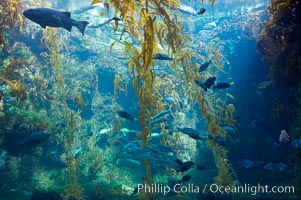
The kelp forest tank in the Stephen Birch Aquarium at the Scripps Institution of Oceanography. The 70000 gallon tank is home to black seabass, broomtail grouper, garibaldi, moray eels and leopard sharks.
Location: Stephen Birch Aquarium, La Jolla, California
Image ID: 14548
Location: Stephen Birch Aquarium, La Jolla, California
Image ID: 14548
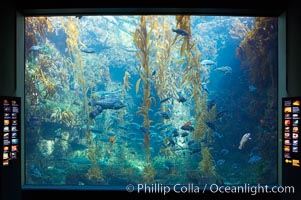
The kelp forest tank in the Stephen Birch Aquarium at the Scripps Institution of Oceanography. The 70000 gallon tank is home to black seabass, broomtail grouper, garibaldi, moray eels and leopard sharks.
Location: Stephen Birch Aquarium, La Jolla, California
Image ID: 14549
Location: Stephen Birch Aquarium, La Jolla, California
Image ID: 14549
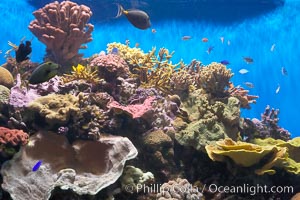
A tropical reef fish tank in the Stephen Birch Aquarium at the Scripps Institution of Oceanography. Built in 1992, the Birch Aquarium has over 60 tanks including a 70000 gallon kelp forest tank and 13000 gallon shark exhibit.
Location: Stephen Birch Aquarium, La Jolla, California
Image ID: 14550
Location: Stephen Birch Aquarium, La Jolla, California
Image ID: 14550
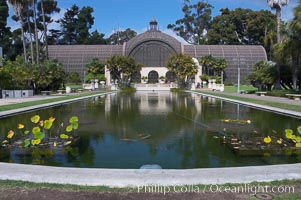
The Botanical Building in Balboa Park, San Diego. The Botanical Building, at 250 feet long by 75 feet wide and 60 feet tall, was the largest wood lath structure in the world when it was built in 1915 for the Panama-California Exposition. The Botanical Building, located on the Prado, west of the Museum of Art, contains about 2,100 permanent tropical plants along with changing seasonal flowers. The Lily Pond, just south of the Botanical Building, is an eloquent example of the use of reflecting pools to enhance architecture. The 193 by 43 foot pond and smaller companion pool were originally referred to as Las Lagunas de las Flores (The Lakes of the Flowers) and were designed as aquatic gardens. The pools contain exotic water lilies and lotus which bloom spring through fall. Balboa Park, San Diego.
Location: Balboa Park, San Diego, California
Image ID: 14575
Location: Balboa Park, San Diego, California
Image ID: 14575
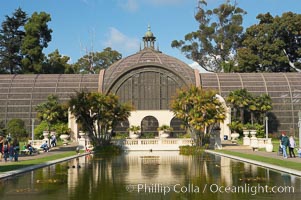
The Botanical Building in Balboa Park, San Diego. The Botanical Building, at 250 feet long by 75 feet wide and 60 feet tall, was the largest wood lath structure in the world when it was built in 1915 for the Panama-California Exposition. The Botanical Building, located on the Prado, west of the Museum of Art, contains about 2,100 permanent tropical plants along with changing seasonal flowers. The Lily Pond, just south of the Botanical Building, is an eloquent example of the use of reflecting pools to enhance architecture. The 193 by 43 foot pond and smaller companion pool were originally referred to as Las Lagunas de las Flores (The Lakes of the Flowers) and were designed as aquatic gardens. The pools contain exotic water lilies and lotus which bloom spring through fall. Balboa Park, San Diego.
Location: Balboa Park, San Diego, California
Image ID: 14576
Location: Balboa Park, San Diego, California
Image ID: 14576
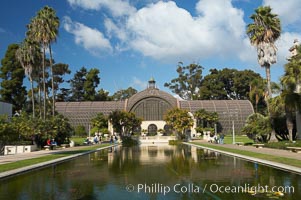
The Botanical Building in Balboa Park, San Diego. The Botanical Building, at 250 feet long by 75 feet wide and 60 feet tall, was the largest wood lath structure in the world when it was built in 1915 for the Panama-California Exposition. The Botanical Building, located on the Prado, west of the Museum of Art, contains about 2,100 permanent tropical plants along with changing seasonal flowers. The Lily Pond, just south of the Botanical Building, is an eloquent example of the use of reflecting pools to enhance architecture. The 193 by 43 foot pond and smaller companion pool were originally referred to as Las Lagunas de las Flores (The Lakes of the Flowers) and were designed as aquatic gardens. The pools contain exotic water lilies and lotus which bloom spring through fall. Balboa Park, San Diego.
Location: Balboa Park, San Diego, California
Image ID: 14577
Location: Balboa Park, San Diego, California
Image ID: 14577
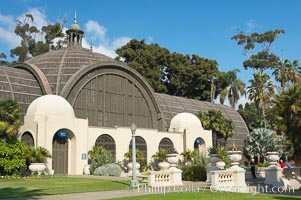
The Botanical Building in Balboa Park, San Diego. The Botanical Building, at 250 feet long by 75 feet wide and 60 feet tall, was the largest wood lath structure in the world when it was built in 1915 for the Panama-California Exposition. The Botanical Building, located on the Prado, west of the Museum of Art, contains about 2,100 permanent tropical plants along with changing seasonal flowers. The Lily Pond, just south of the Botanical Building, is an eloquent example of the use of reflecting pools to enhance architecture. The 193 by 43 foot pond and smaller companion pool were originally referred to as Las Lagunas de las Flores (The Lakes of the Flowers) and were designed as aquatic gardens. The pools contain exotic water lilies and lotus which bloom spring through fall. Balboa Park, San Diego.
Location: Balboa Park, San Diego, California
Image ID: 14579
Location: Balboa Park, San Diego, California
Image ID: 14579
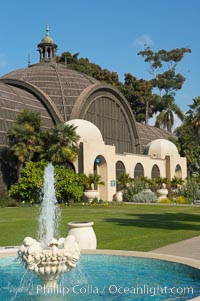
The Botanical Building in Balboa Park, San Diego. The Botanical Building, at 250 feet long by 75 feet wide and 60 feet tall, was the largest wood lath structure in the world when it was built in 1915 for the Panama-California Exposition. The Botanical Building, located on the Prado, west of the Museum of Art, contains about 2,100 permanent tropical plants along with changing seasonal flowers. The Lily Pond, just south of the Botanical Building, is an eloquent example of the use of reflecting pools to enhance architecture. The 193 by 43 foot pond and smaller companion pool were originally referred to as Las Lagunas de las Flores (The Lakes of the Flowers) and were designed as aquatic gardens. The pools contain exotic water lilies and lotus which bloom spring through fall. Balboa Park, San Diego.
Location: Balboa Park, San Diego, California
Image ID: 14580
Location: Balboa Park, San Diego, California
Image ID: 14580
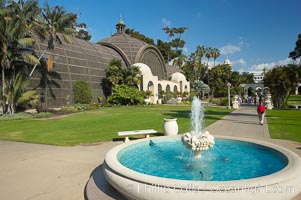
The Botanical Building in Balboa Park, San Diego. The Botanical Building, at 250 feet long by 75 feet wide and 60 feet tall, was the largest wood lath structure in the world when it was built in 1915 for the Panama-California Exposition. The Botanical Building, located on the Prado, west of the Museum of Art, contains about 2,100 permanent tropical plants along with changing seasonal flowers. The Lily Pond, just south of the Botanical Building, is an eloquent example of the use of reflecting pools to enhance architecture. The 193 by 43 foot pond and smaller companion pool were originally referred to as Las Lagunas de las Flores (The Lakes of the Flowers) and were designed as aquatic gardens. The pools contain exotic water lilies and lotus which bloom spring through fall. Balboa Park, San Diego.
Location: Balboa Park, San Diego, California
Image ID: 14581
Location: Balboa Park, San Diego, California
Image ID: 14581
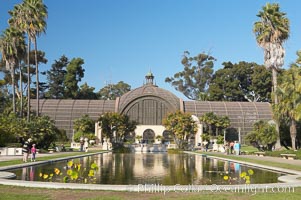
The Botanical Building in Balboa Park, San Diego. The Botanical Building, at 250 feet long by 75 feet wide and 60 feet tall, was the largest wood lath structure in the world when it was built in 1915 for the Panama-California Exposition. The Botanical Building, located on the Prado, west of the Museum of Art, contains about 2,100 permanent tropical plants along with changing seasonal flowers. The Lily Pond, just south of the Botanical Building, is an eloquent example of the use of reflecting pools to enhance architecture. The 193 by 43 foot pond and smaller companion pool were originally referred to as Las Lagunas de las Flores (The Lakes of the Flowers) and were designed as aquatic gardens. The pools contain exotic water lilies and lotus which bloom spring through fall. Balboa Park, San Diego.
Location: Balboa Park, San Diego, California
Image ID: 14583
Location: Balboa Park, San Diego, California
Image ID: 14583
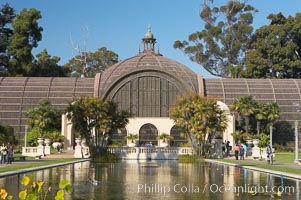
The Botanical Building in Balboa Park, San Diego. The Botanical Building, at 250 feet long by 75 feet wide and 60 feet tall, was the largest wood lath structure in the world when it was built in 1915 for the Panama-California Exposition. The Botanical Building, located on the Prado, west of the Museum of Art, contains about 2,100 permanent tropical plants along with changing seasonal flowers. The Lily Pond, just south of the Botanical Building, is an eloquent example of the use of reflecting pools to enhance architecture. The 193 by 43 foot pond and smaller companion pool were originally referred to as Las Lagunas de las Flores (The Lakes of the Flowers) and were designed as aquatic gardens. The pools contain exotic water lilies and lotus which bloom spring through fall. Balboa Park, San Diego.
Location: Balboa Park, San Diego, California
Image ID: 14584
Location: Balboa Park, San Diego, California
Image ID: 14584
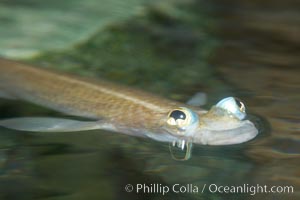
Four-eyed fish, found in the Amazon River delta of South America. The name four-eyed fish is actually a misnomer. It has only two eyes, but both are divided into aerial and aquatic parts. The two retinal regions of each eye, working in concert with two different curvatures of the eyeball above and below water to account for the difference in light refractivity for air and water, allow this amazing fish to see clearly above and below the water surface simultaneously.
Species: Four-eyed fish, Anableps anableps
Image ID: 14719
Species: Four-eyed fish, Anableps anableps
Image ID: 14719
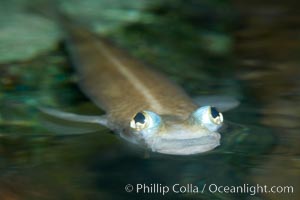
Four-eyed fish, found in the Amazon River delta of South America. The name four-eyed fish is actually a misnomer. It has only two eyes, but both are divided into aerial and aquatic parts. The two retinal regions of each eye, working in concert with two different curvatures of the eyeball above and below water to account for the difference in light refractivity for air and water, allow this amazing fish to see clearly above and below the water surface simultaneously.
Species: Four-eyed fish, Anableps anableps
Image ID: 14720
Species: Four-eyed fish, Anableps anableps
Image ID: 14720
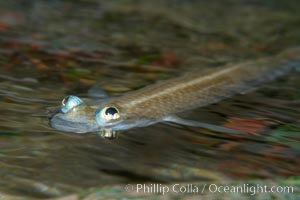
Four-eyed fish, found in the Amazon River delta of South America. The name four-eyed fish is actually a misnomer. It has only two eyes, but both are divided into aerial and aquatic parts. The two retinal regions of each eye, working in concert with two different curvatures of the eyeball above and below water to account for the difference in light refractivity for air and water, allow this amazing fish to see clearly above and below the water surface simultaneously.
Species: Four-eyed fish, Anableps anableps
Image ID: 14721
Species: Four-eyed fish, Anableps anableps
Image ID: 14721
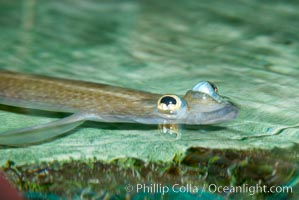
Four-eyed fish, found in the Amazon River delta of South America. The name four-eyed fish is actually a misnomer. It has only two eyes, but both are divided into aerial and aquatic parts. The two retinal regions of each eye, working in concert with two different curvatures of the eyeball above and below water to account for the difference in light refractivity for air and water, allow this amazing fish to see clearly above and below the water surface simultaneously.
Species: Four-eyed fish, Anableps anableps
Image ID: 14722
Species: Four-eyed fish, Anableps anableps
Image ID: 14722
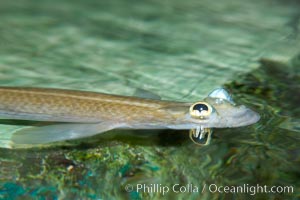
Four-eyed fish, found in the Amazon River delta of South America. The name four-eyed fish is actually a misnomer. It has only two eyes, but both are divided into aerial and aquatic parts. The two retinal regions of each eye, working in concert with two different curvatures of the eyeball above and below water to account for the difference in light refractivity for air and water, allow this amazing fish to see clearly above and below the water surface simultaneously.
Species: Four-eyed fish, Anableps anableps
Image ID: 14723
Species: Four-eyed fish, Anableps anableps
Image ID: 14723
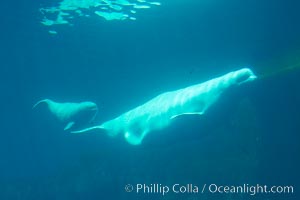
Beluga whale mother and calf.
Location: Vancouver Aquarium, British Columbia, Canada
Image ID: 21171
Location: Vancouver Aquarium, British Columbia, Canada
Image ID: 21171
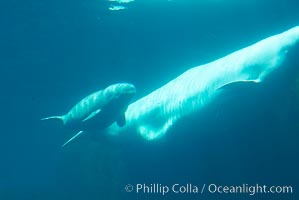
Beluga whale mother and calf.
Location: Vancouver Aquarium, British Columbia, Canada
Image ID: 21172
Location: Vancouver Aquarium, British Columbia, Canada
Image ID: 21172
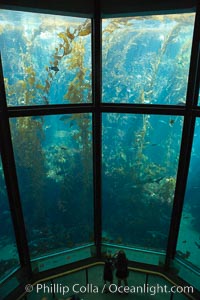
Giant kelp forest tank, Monterey Bay Aquarium.
Image ID: 21537
Image ID: 21537
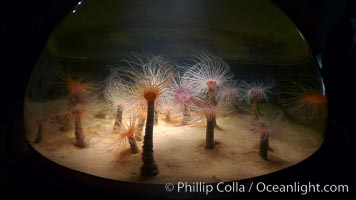
Tube anemones in a clear globe display at the Monterey Bay Aquarium.
Species: Tube anemone, Pachycerianthus fimbriatus
Location: Monterey, California
Image ID: 21500
Species: Tube anemone, Pachycerianthus fimbriatus
Location: Monterey, California
Image ID: 21500
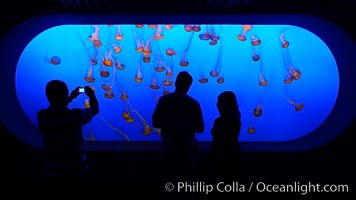
Visitors enjoy viewing sea nettle jellyfish at the Monterey Bay Aquarium.
Species: Sea nettles, Chrysaora fuscescens
Location: Monterey, California
Image ID: 21501
Species: Sea nettles, Chrysaora fuscescens
Location: Monterey, California
Image ID: 21501
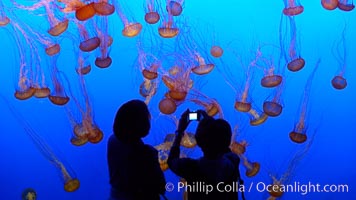
Visitors enjoy viewing sea nettle jellyfish at the Monterey Bay Aquarium.
Species: Sea nettles, Chrysaora fuscescens
Location: Monterey, California
Image ID: 21502
Species: Sea nettles, Chrysaora fuscescens
Location: Monterey, California
Image ID: 21502
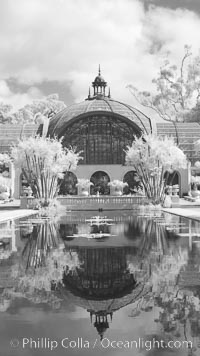
The Botanical Building in Balboa Park, San Diego. The Botanical Building, at 250 feet long by 75 feet wide and 60 feet tall, was the largest wood lath structure in the world when it was built in 1915 for the Panama-California Exposition. The Botanical Building, located on the Prado, west of the Museum of Art, contains about 2,100 permanent tropical plants along with changing seasonal flowers. The Lily Pond, just south of the Botanical Building, is an eloquent example of the use of reflecting pools to enhance architecture. The 193 by 43 foot pond and smaller companion pool were originally referred to as Las Lagunas de las Flores (The Lakes of the Flowers) and were designed as aquatic gardens. The pools contain exotic water lilies and lotus which bloom spring through fall.
Location: Balboa Park, San Diego, California
Image ID: 23098
Location: Balboa Park, San Diego, California
Image ID: 23098
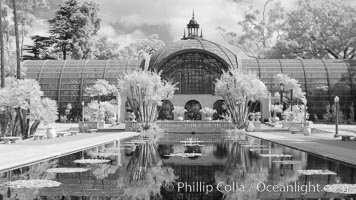
The Botanical Building in Balboa Park, San Diego. The Botanical Building, at 250 feet long by 75 feet wide and 60 feet tall, was the largest wood lath structure in the world when it was built in 1915 for the Panama-California Exposition. The Botanical Building, located on the Prado, west of the Museum of Art, contains about 2,100 permanent tropical plants along with changing seasonal flowers. The Lily Pond, just south of the Botanical Building, is an eloquent example of the use of reflecting pools to enhance architecture. The 193 by 43 foot pond and smaller companion pool were originally referred to as Las Lagunas de las Flores (The Lakes of the Flowers) and were designed as aquatic gardens. The pools contain exotic water lilies and lotus which bloom spring through fall.
Location: Balboa Park, San Diego, California
Image ID: 23103
Location: Balboa Park, San Diego, California
Image ID: 23103
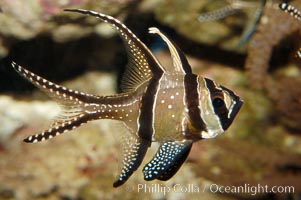
Banggai Cardinalfish. Once thought to be found at Banggai Island near Sulawesi, Indonesia, it has recently been found at Lembeh Strait and elsewhere. The male incubates the egg mass in his mouth, then shelters a brood of 10-15 babies in his mouth after they hatch, the only fish known to exhibit this behaviour. Unfortunately, the aquarium trade is threatening the survival of this species in the wild.
Species: Banggai cardinalfish, Pterapogon kauderni
Image ID: 08900
Species: Banggai cardinalfish, Pterapogon kauderni
Image ID: 08900
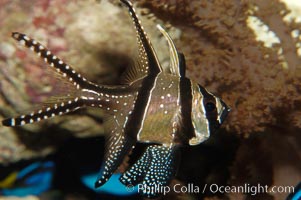
Banggai Cardinalfish. Once thought to be found at Banggai Island near Sulawesi, Indonesia, it has recently been found at Lembeh Strait and elsewhere. The male incubates the egg mass in his mouth, then shelters a brood of 10-15 babies in his mouth after they hatch, the only fish known to exhibit this behaviour. Unfortunately, the aquarium trade is threatening the survival of this species in the wild.
Species: Banggai cardinalfish, Pterapogon kauderni
Image ID: 08901
Species: Banggai cardinalfish, Pterapogon kauderni
Image ID: 08901
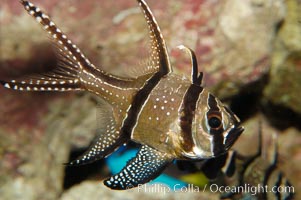
Banggai Cardinalfish. Once thought to be found at Banggai Island near Sulawesi, Indonesia, it has recently been found at Lembeh Strait and elsewhere. The male incubates the egg mass in his mouth, then shelters a brood of 10-15 babies in his mouth after they hatch, the only fish known to exhibit this behaviour. Unfortunately, the aquarium trade is threatening the survival of this species in the wild.
Species: Banggai cardinalfish, Pterapogon kauderni
Image ID: 08902
Species: Banggai cardinalfish, Pterapogon kauderni
Image ID: 08902
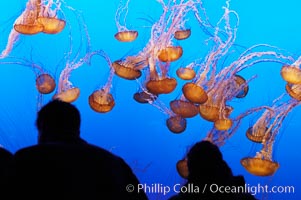
Visitors watch a graceful, slow moving group of sea nettle jellyfishes at the Monterey Bay Aquarium.
Species: Sea nettles, Chrysaora fuscescens
Location: Monterey, California
Image ID: 08966
Species: Sea nettles, Chrysaora fuscescens
Location: Monterey, California
Image ID: 08966
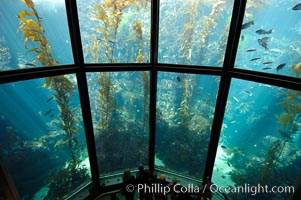
Visitors enjoy the enormous kelp forest tank at the Monterey Bay Aquarium.
Location: Monterey, California
Image ID: 09069
Location: Monterey, California
Image ID: 09069
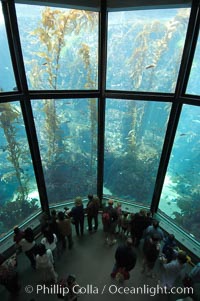
Visitors enjoy the enormous kelp forest tank at the Monterey Bay Aquarium.
Location: Monterey, California
Image ID: 09070
Location: Monterey, California
Image ID: 09070